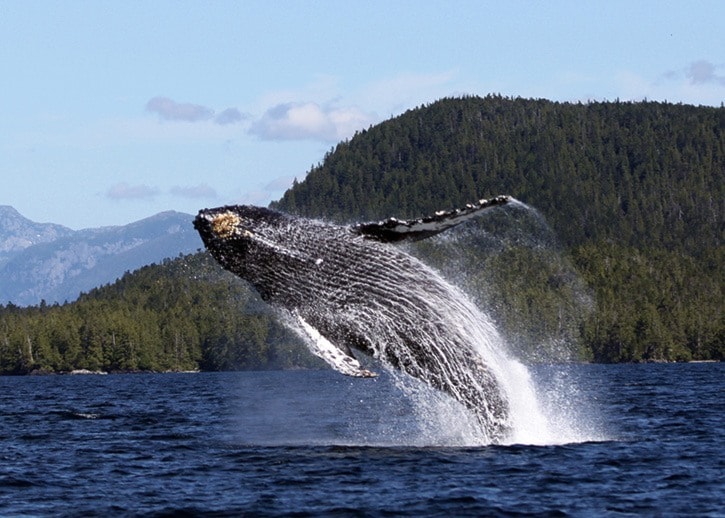It’s no fluke.
There’s a growing body of evidence that shows the area around Gil Island is actually a very important habitat for humpback whales.
A scientific study into the abundance of humpback whales was published on September 12, showed that at least in the immediate area of Gil Island, the threatened humpback whale continues to grow at a remarkable pace.
Naturally researchers are now cautioning that industrial development with increased marine traffic could pose a threat to the whales.
The report comes after an eight year study done by researches from the University of St. Andrews, Cetacea Lab, and the Gitga’at Lands and Marine Resources Department.
Among the reports findings are that eight per cent of B.C.’s humpback whale population use the waters around Gil Island, an area which represents just 1.5 per cent of B.C.’s inland coast.
Also, from 2004 to 2011, the number of whales doubled in the area, to an average summer population of 140.
“We just wanted to get a better understanding of which species are in the area, what different parts of the area are they using, and how many there are,” said Chris Picard, science director for the Gitga’at First Nation, in which the territory study took place.
“Down the road we want to, with that better understanding, develop recommendations or strategies that could assist in their conservation,” he added.
The idea to do this study came from anecdotal evidence that there just seemed to be a lot of whales in the area.
Janie Wray, a whale researcher for Cetacea Lab, said they first arrived at Hartley Bay to seek permission to install a whale monitoring station in 2000, and were fortunate to be allowed.
“We built the station on Gil Island and put in a number of hydrophone stations that allowed us to listen to whales,” she said.
“Initially the project, when we first came, was geared more towards Killer Whales and we started to notice all these humpback whales,” added Wray.
“Every year we noticed the population growing and growing.”
She said that between 2004 and 2009, the number of humpbacks, which started at 42 in 2004, had doubled.
The report led the researchers to a few key conclusions.
The first and most obvious, of course, is proof that there are a lot of whales in the area, which is encouraging for the species’ overall recovery.
The other is the realization that Gil Island, researchers see now, is important, likely primarily as a food source for the whales, said Picard.
“There seems to be a particular richness in this area, because compared to other parts of the coast, whales are far more abundant in the area where we studied.”
Wray adds that there could be a social connection for the whales as well which brings them out.
“The amount of singing that occurs between humpback whales in the fall has also increased,” she said. “And I think right now it’s relatively quiet, this is a place they can come, communicate freely, they can find their prey easily by using sound because the ocean is so quiet through these channels.”
Underlying these findings, of course, is the threat that tanker traffic could have on populations.
“Certainly part of the reason we did our study was keeping in mind the proposed developments that would increase shipping traffic,” said Picard. “As many people are aware, increasing shipping traffic does present potential problems for whales in terms of the noise pollution.”
“Then of course there’s oil spills. Oil spills damage all parts of the environment and whales are no exceptions,” he added.
That damage comes from the contact with whales directly and to their food supply, he said.
With such a concentration of whales, researchers also point to the potential of whale strikes against ships.
Researchers are meanwhile beginning to see a bigger picture relating to the fin whales as well, a relative of humpbacks.
The second largest mammal in the world, said Picard, fin whales are seeing a growing abundance in the area, which is actually peculiar because they’re known to be more open ocean whales.
“I’m particularly curious to find out what it is about these waters that makes them so productive,” he said.
Wray is equally excited about learning more as well.
“There’s a big fin whale story going on here. That’s pretty huge.”
Meanwhile researchers continue to collect information, and Wray said she’ll be looking at the social relationship of whales in the area, as well as monitoring the survival of calves after they leave their mothers.
